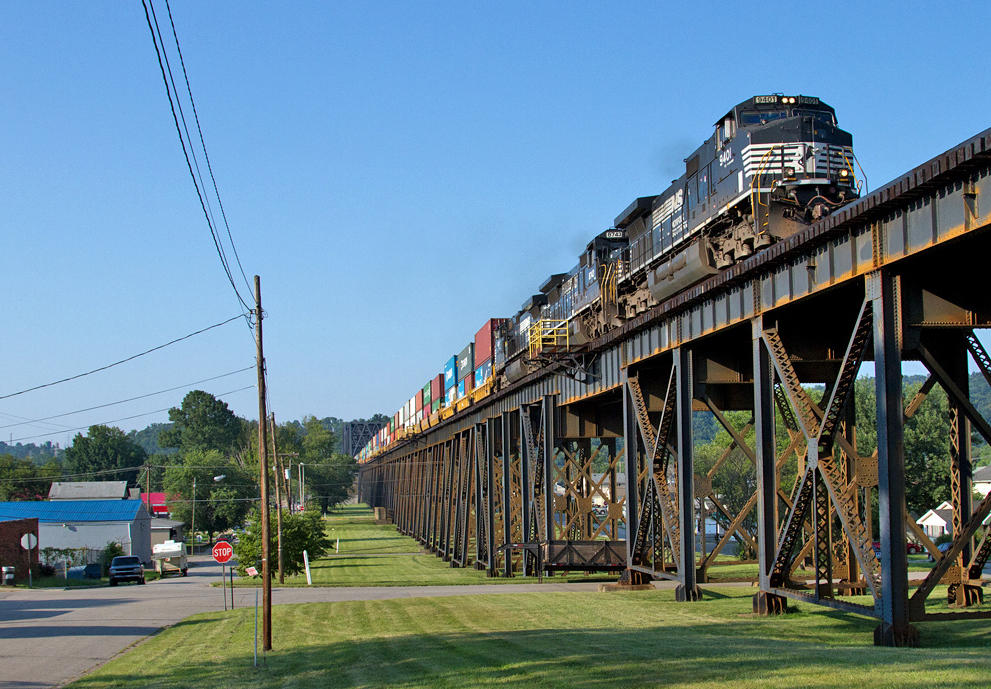
NEW YORK — East Coast ports are handling a record number of containers due to ongoing supply chain issues in California and the West, but railroads aren’t seeing this equate to more intermodal volume for a number of reasons.
First, rail doesn’t have the same international intermodal market share in the East as it does in the West because East Coast ports are a shorter distance, within 500 miles or so, of markets like Atlanta, Pittsburgh, Cleveland, or Buffalo, N.Y. These shorter hauls are more attractive to trucks, as opposed to markets in Kansas City, Dallas, or Chicago that are at least 1,500 miles from the Pacific Coast. In these lanes, international intermodal is more likely to use rail from the West.
For East Coast lanes conducive for rail, opportunities are periodically hindered by labor and equipment issues and constrained warehouse space, as reported recently in the Wall Street Journal. Also an issue is tight drayage capacity that’s requiring international containers to be transloaded close to the port, so the containers can quickly be reloaded onto container ships. These circumstances make it difficult for railroads to capture the influx of containers arriving at East Coast ports. Trucks capture most of the business and complete the first-last mile deliver to consuming markets.
Norfolk Southern handled 4.104 million intermodal units in 2021, a 2.4% decrease from 2019’s 4.207 million units. While the Class I railroad has nearly eclipsed pre-pandemic intermodal volume, the railroad has not experienced the intermodal growth like the East Coast ports it serves. In comparison, CSX Transportation handled 2.976 million intermodal units in 2021, an 11.4% increase from 2019’s 2.670 million units. It is the railroad’s best year for intermodal in recent history and is slightly more aligned with growth at ports.
Combined, the railroads’ volume trails the increases recorded at the East Coast’s top ports, based on comparison 20-foot-equivalent units (TEUs) in 2021 to pre-pandemic 2019.
The Port of New York and New Jersey, the East Coast’s busiest port, handled 8.9 million TEUs, a 22% increase; Georgia’s Port of Savannah, 5.6 million TEUs, also a 22% increase; Port of Virginia, 3.5 million TEUs, a 19% increase; South Carolina Ports, 2.7 million TEUs, a 12% increase; and Port of Miami .1.2 million TEUs, a 11% increase. Combined, these five top ports handled 3.5 million more TEUs in 2021 compared to pre-pandemic figures for 2019.
As drayage capacity improves, railroads should be able to haul more international containers currently relying on trucks. They should also haul more intomrodal as rail network velocities improve. It will remain equally important for inland ports to make sure they can continue to process the inbound volume efficiently, as unexpected delays there will cause shippers to bypass rail-served facilities entirely. Such was the case in July 2021 when inland port congestion in the Chicago area prompted intermodal embargoes [see “Union Pacific suspends inbound international container shipments …,” Trains News Wire, July 14, 2021].
Railroads may be able to capture incremental volume on truck-competitive lanes close to or more than 500 miles from ports, as congestion recedes elsewhere in the supply chain or as railroad network capacities improve. In the near term, these circumstances make it difficult to forecast how railroads will fare.
So far in 2022, West Coast intermodal rail is down more than 10% at BNSF Railway and 4% at Union Pacific. In the East, NS’s intermodal is down 15%, while CSX is down more than 1% from a year ago.
For the year to date, the Association of American Railroads reports U.S. intermodal traffic is down more than 7% compared to 2021, signaling that U.S. railroads have the capacity to handle more traffic, if only the environment was more conducive for railroads.
— Trains correspondent Bill Stephens contributed to this report.














The GPA inland port in Murray County is handling boxes, sure, but I’d hardly call it a rip roaring success. It’s victimized by a CSX service scheme that takes the containers “around the horn” from Savannah–south via Waycross, THEN north. THEN, the boxes hang around Fairburn waiting for what, last time I heard, was a tri-weekly run up to the inland port. The fruit that GPA didn’t elect to pick? The tremendous number of containers that are drayed every day back and forth to Kia at West Point and Hyundai at Snowdoun, Alabama. State highways and I-16 are full of daycabs handling these boxes. CSX is happy to handle the finished output of these plants, but as for inbound parts?
I believe the industry is going to need to re-think both operations procedures an d equipment allocations. The expense of trans-loading containers and assembling mega-trains destroys capacity, timely operation and flexibility. Something like the Flexi-van or Road-Railer of yester-year would eliminate the need of expensive trans-load facilities at the added expense of road wheel bogies. Moreover, it could make far more destinations economically available. The world isn’t necessarily wedded to the TEU in its current form. I think the future will look more like the European mode than the mega-train.
Getting rid of the frictional inefficiencies inherent in the current system should be a top priority. Making drivers wait for hours to pick up/off-load is a major avoidable expense. for everyone.
Dray, port, and terminal cost will destroy marigns on any short haul IM moves. How to reduce those cost? We’re still trying to figure that out….
So how exactly do you explain the apparent success of the Georgia and South Carolina short haul programs???
Those moves are subsidized by the ports.. Do any C1’s offer such service without subsidy? No.. Port of LA/LB to Inland Empire is another example of why containers move via 710 to Colton, Ontario, etc….Container terminals are a high cost operation rquring long haul and high volume. Jim you should know this..
Braden, please answer the original question (if you can). As I recall it was about successful short haul operations in the states of Georgia and South Carolina not some unintelligible references to something in California. Your very confusing response is totally irrelevant to my very specific example (and the original question I posed).
My two examples here are parts of integrated global supply chains which is why they work so well. Who cares if they are subsidized by the Ports? They represent creative out-of-the box thinking most US railroaders seem incapable of. Apparently, the customers love the service.
Ironically, the end result of the process for the uncreative railroaders is some very lucrative finished automobile traffic out of the BMW plant in Spartanburg, SC.
All of this bodes very well for continued growth in Savannah and Charleston and the continued decline of the southern California ports. Nothing succeeds like success!
The BMW plant is in Greer, SC.
I posted earlier on this…Sea Land is moving a portion of their Asia container movements to Jaxport in Jacksonville Florida. Served by both CSX and NS.
US East Coast ports are small but many. The State of Florida alone has some 7 ports. Pensacola, Tampa, Miami, Ft Lauderdale, Canaveral, Fernandina and Jacksonville.
Could on dock/near dock rail help any? It could expedite the process it seems. The proposed intermodal container transfer facility at the new Leatherman terminal at the port of Charleston will be set up as a near dock terminal.
Massive terminal handling investments at the Ports are the KEY here. In November 2021 GPA announced the completion of a $200 million-plus expansion of the Mason Mega Terminal at Savannah. This addition reportedly increased rail handling capacity at the port by 30 percent. The rails will NOT enjoy the additional container volumes until they have the terminal facilities to do so. East Coast ports are all playing catch-up to investments made at West Coast ports decades ago. Again, it all goes back to the “first-mile/last-mile” issues.
Just compare Norfolk Southern’s published schedules from as recently as Q1 2019 to today. There were dedicated trains from Elizabeth Marine to Chicago, Elizabeth to Harrisburg, and GCT Bayonne + Staten Island NYCT to Harrisburg. GCT was completed at the start of 2019 and could handle the largest vessels, so they added a pair of trains to expedite containers to connections in Harrisburg. That represented hundreds of TEU’s worth of new business on each train. I still have the pdf of the new service offering.
In 2022, there’s one train pair that serves all 3 of these docks, and it rarely keeps on any sort of schedule. Most of the traffic from GCT, with many of the steamship lines being longtime NS customers, now moves via road or on CSX. It’s sad.
We would disagree with most of these comments. The primary issue here is once again “first-mile/last-mile” which can also be described as the modal interface. Both the Port of Charleston and the Georgia Ports Authority have had great success setting up their own proprietary networks of inland ports. Also remember that on the West Coast rail market share of the total imports is less than 30 percent. The conventional wisdom has always been that about 70 percent of all imports stay within the state of California. We are not aware of any short haul intermodal service in this market either.
The combination of big ships and big trains would appear to be marriage made in heaven. But transportation is a derived demand business, and the boxes go where the shippers want them to go not the railroads. In the east most of the rail main lines suffer from serious circuity issues when compared with the interstate highway network.
Here in the Chicago area west coast imports terminate at two of the largest intermodal terminals in the world on BNSF and UP. By comparison neither one of the eastern railroads have anything comparable.
MR GIBLIN — Interesting thoughts but I’d turn it around — maybe the western RRs intermodal terminals are too big, as opposed to the eastern RRs intermodal terminals being too small. To me, “intermodal” is a euphemism for highway congestion. I’d hate to live or drive or drives the roads within several miles of the intermodal terminal that receives a three mile long double-stack train. How can the terminal even function? And what is its environmental footprint?
Maybe what we need is a larger number of smaller terminals. For example I live in the Milwaukee area. Why should drayage for Milwaukee area customers start from or end at one of these mega-huge yards in Chicagoland? Not just the extra dray distance but also the wait times for a drayer to get into or out of the terminal.
I suspect the real answer here is that one size does not fit all. I cannot imagine anyway to handle the large volumes coming to Chicago without the enormous capacity represented by LPC and Global 4. The flip side of the argument is look at the inland port solutions in South Carolina and Georgia. The GPA solution involves short haul trains operating via numerous smaller terminals instead of trying to cram everything into the legacy terminals in Atlanta. We were blessed with an incredible amount of open empty land in nearby Will County 20 years ago which made this work.
BTW, a number of years ago SC Johnson looked at building and operating their own intermodal terminal at their facility in Sturtevant. Great idea but too many institutional barriers at t the time.
Insofar as intermodal, I would anticipate favorable changes at NS once Squires leaves in a few months and Alan Shaw assumes the CEO role. With Alan at the top and Mike McClellan over strategy, you have two gentlemen who were instrumental in developing NS’ intermodal network before Jim Squires’ derailment into the psr nonsense began wrecking NS.
One more badly needed “retirement”: Cindy Sanborn. She was thrown out of CSX, ineffective at UP, and now has virtually destroyed reliable service at NS. Bring back Tony Ingram, a real railroader and no-nonsense ops guy.!
AL Dicenso , as a fan of your posted wisdom, you really date yourself and a host of intelligent, in the trenches , railroaders. Get with the current maniacal trends. Sanborn is just the tip of the sinking ship iceberg the industry has become. Recognize that sex, racial, transgender, climate fanatics are the flavor of the day. Qualified operations savvy has fallen by the wayside, and failure is the new religion
Possibly with the recently precipitous price of deiseal fuel increases, maybe rail will become a more attractive alternative in the shorter haul markets. Rail needs to act while the opportunity exists.
Had Conrail still been around, or NS management actually been interested in growing the railroad, how different might this have been? These relatively short hauls have been done successfully in the not so distant past. But you can;t grow traffic when servicing the customer and going after new business is an afterthought lost in the endless quest by bottom feeder investors to milk every cent from the railroad without regard to the long term health of the company.
I too wonder if PSR is restraining the intermodal growth.
How can velocity improve if tracks disappear from service, and supper long PSR trains are the rule? It will take a wholesale re think and redo of the rail transportation business in the US to make not bulk commodity trains viable at 500 miles. (And yet they do it in England and Europe all day long.)